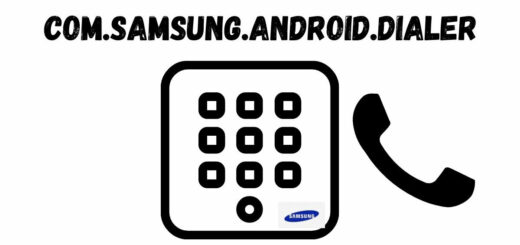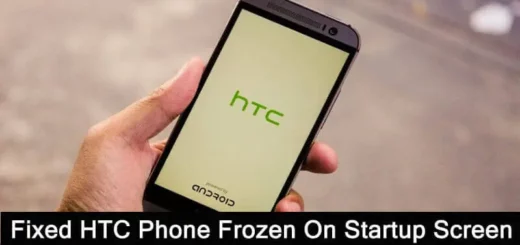What is MDM App Android: A Comprehensive Guide
Are you curious about the mysterious MDMApp on your Android phone? Have you ever wondered what it is and why it’s there? In this comprehensive guide, we will demystify MDMApp and provide you with all the information you need to understand its purpose and functionality.
From understanding what Android Mobile Device Management (MDM) is to exploring the specific use of MDMApp on Android phones, we’ll cover it all. We’ll also address common concerns such as whether MDMApp is safe or a virus and if it can be considered spyware.
Additionally, we’ll delve into why enterprises need Android device management software and highlight the features of Android MDM software. So, if you’ve been curious about MDMApp and its role in device management, keep reading to find out everything you need to know.
What is Android Mobile Device Management (MDM)?
Android device management involves overseeing, securing, and distributing devices running on the Android OS in a corporate setting. Tasks include enrollment, enforcing security policies, app installation, remote wiping of lost devices, and monitoring usage.
It can be achieved through mobile device management (MDM) software or the Android Enterprise platform, ensuring device security and compliance with corporate policies while empowering employees with the resources they need.
Android devices dominate the market, used for work purposes, posing challenges in securing and managing them, whether brought by employees (BYOD) or corporate-owned.
What Is MDM app on Android Phones?
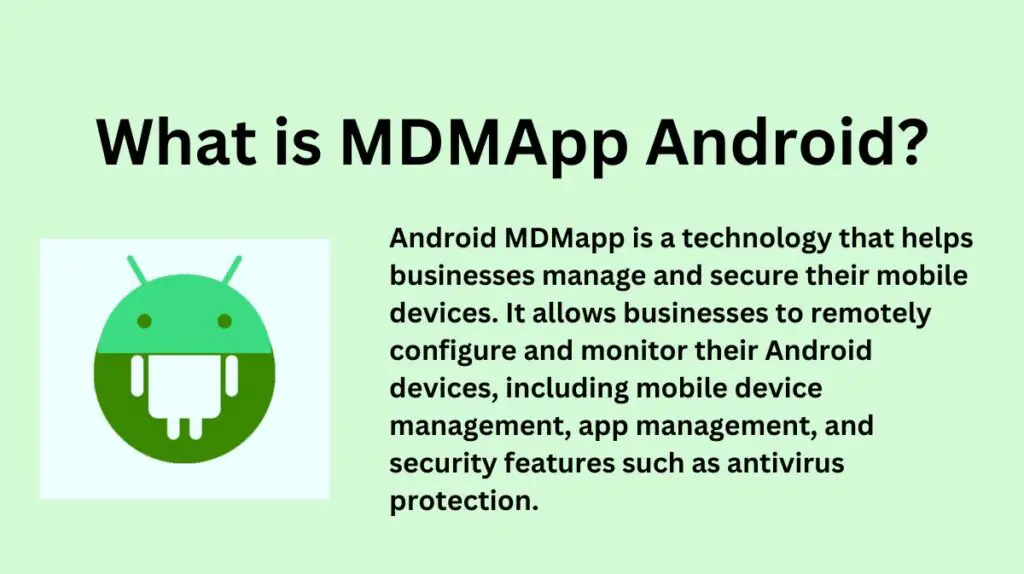
MDM in general is used to manage, secure, and monitor all the enrolled mobile devices.
To enable an enterprise to remotely configure and control enrolled Android devices via an MDM server, it is essential to have an agent installed on each device. This agent is responsible for receiving the configurations and applying them to the device. In essence, this agent functions as the core component of the MDM app on Android devices.
The MDM App acts as an agent to facilitate communication between the MDM server and the managed Android device. Through this app, various settings such as device configurations, location tracking policies, remote actions, network setups, and device restrictions can be deployed and enforced on the managed Android device.
What is MDM app in Samsung?
Knox Manage, the MDM App from Samsung is an Advanced Mobile Device Management software featuring an intuitive cloud-based console, that is designed for Samsung devices, enabling easy IT administration, data sharing, and heightened security without being tied to a specific carrier.
Samsung advertises this as, “Your cloud-based mobile command center.”
It collaborates with MCM Client, facilitating secure access to Android documents and media. It features built-in Kiosk mode and has event-based policies (for example: blocking employees’ camera access during working hours). It also has support for Android Enterprise which lets you to take advantage of Android Enterprise fully managed and work profile modes.
So Knox Manage, Samsung’s MDM App ensures smooth synchronization with the cloud console, streamlining management tasks and making it an essential component of your device’s functionality. With its Enterprise level capabilities for crucial data, MDM App enhances the overall efficiency, providing unparalleled convenience and peace of mind for big companies with thousands of users.
What is the use of the MDM App on Android?
The MDM app agent is an Advanced Mobile Device Management system similar to ELM Agent. Its primary purpose is to securely manage and track installed apps, sync files, and provide access to device-related information.
Additionally, it enables remote management and control of the device through agents like MCM, facilitating data access via various transmission methods such as USB, Wi-Fi, GPRS, or 3G. With MDM, users can enjoy a secure and efficient way of accessing files and data on their devices while maintaining control and management capabilities.
Here are some functionality of the MDM App on Android
- App Installation
- File Synchronization
- Function Lock
- Satellite Tracking
- Password Enforcement
- Remote Data Deletion
These functionalities collectively empower organizations to manage and secure their Android devices efficiently, ensuring data protection, compliance with policies, and optimal device performance.
How to Know if MDM Is on My Android Phone?
To determine if Mobile Device Management (MDM) is enabled on your Android phone, follow these steps:
- Check Settings: Go to the Settings app on your Android device.
- Look for “Device Administrator” or “Security & Location” (the exact wording may vary depending on your Android version and device).
- Device Administrator: If your device has MDM enabled, you should see a list of apps or services that have administrative access to your device. These apps are granted special privileges and control over certain aspects of your phone. Generally, MDM apps will be listed here if they are active on your device.
- Check Device Owner: If you suspect your device might be managed by an MDM solution, it may also have a Device Owner tag set by the organization managing it. To check this, you can follow these steps:
- Go to Settings > About Phone.
- Look for “Device Owner” or “Owner” information. If there’s a name or organization mentioned, it means your device is managed by an MDM.
Notifications: MDM solutions often display notifications or persistent icons on your device’s status bar. These notifications may indicate that your device is being managed by an MDM system.
App Presence: If you notice any unfamiliar apps on your device that you didn’t install yourself, especially ones with a corporate or company logo, it’s possible that they are part of the MDM setup.
What Permission Does the MDM App Use?
MDM apps require specific permissions to manage and control devices. These permissions include device administration, accessibility access, and app usage access. The android permission names are given respecitvely as follows:
- Camera:
android.permission.CAMERA - Contacts:
android.permission.READ_CONTACTS - Location:
android.permission.ACCESS_FINE_LOCATION - Storage:
android.permission.READ_EXTERNAL_STORAGE - Telephone (IMEI, MEID, and serial number):
android.permission.READ_PHONE_STATE - Network Communication:
android.permission.ACCESS_NETWORK_STATE - Turn on the screen calls:
android.permission.SYSTEM_ALERT_WINDOW - Device Locking and Wiping:
android.permission.BIND_DEVICE_ADMIN - Remote Support:
android.permission.BIND_REMOTEVIEWS - Accessibility Access–
android.permission.BIND_ACCESSIBILITY_SERVICE - App Usage Access–
android.permission.PACKAGE_USAGE_STATS
Is MDMapp Safe or a virus?
MDM apps are generally safe when used for legitimate purposes in organizations. However, if installed without consent on personal devices or used for malicious intent, they could be considered a security risk or even a type of virus.
Is MDM app Spyware?
MDM apps are not spyware by nature, as their primary purpose is to manage and monitor devices within organizations. However, if used without consent on personal devices for unauthorized data collection, they can be considered spyware.
Is It Possible to Uninstall the MDM app?
The possibility of uninstalling an MDM app depends on the device’s ownership and company policies. If the device is personal, you can typically uninstall the app. However, on company-owned devices or those under management, removing the MDM app might be restricted due to security and data control reasons. Always check with your organization’s IT department for guidance.
How to Uninstall the MDM app?
To uninstall the MDM app from your Android device, follow these steps:
- Open the “Settings” on your Android device.
- Go to “Apps.”
- Tap on the vertical ellipsis menu (three dots) at the top right corner.
- Select “Show system Apps” from the menu.
- Find the MDM app with the package name “com.samsung.android.mdm” and tap to open it.
- Tap “Uninstall” to remove the MDM app.
- After uninstalling, go back to the home screen or main settings.
- Restart your Android device.
Does a Factory Reset Remove MDM?
A factory reset may remove the MDM configuration and any MDM apps installed on the device. However, the specific outcome may depend on the device and MDM settings.
Why do enterprises need Android device management software?
Enterprises require Android device management software for various compelling reasons. An Android device management tool or solution can offer the following benefits:
- Boosting Device Security: By enforcing Android device management policies and protocols, the software safeguards against data breaches and unauthorized access, enhancing overall device security.
- Streamlining Device Configuration: The IT team can effortlessly set up and deploy Android devices throughout the organization, thanks to the streamlined device configuration provided by the software.
- Simplifying Application Management: The software allows centralized control over app deployment and updates, making application management a hassle-free process.
- Facilitating Remote Monitoring and Support: With remote monitoring and support capabilities, the software helps in reducing downtime and increasing productivity by addressing issues without the need for physical device access.
Features of an Android MDM software-
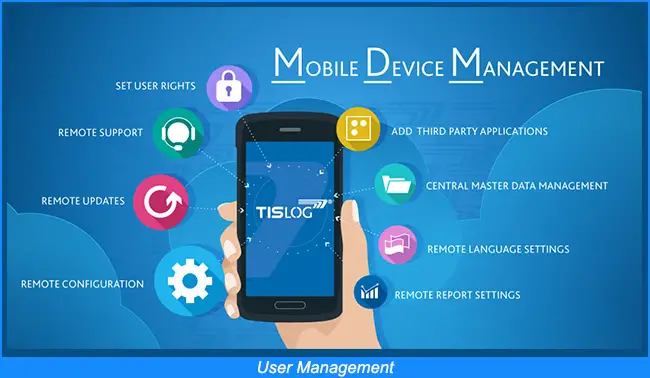
Android Device enrollment
Android Device Enrollment is a vital feature in Android Mobile Device Management (MDM) software, essential for both corporate and personally-owned devices.
It streamlines the setup process by automating device configuration and policy application, resulting in increased security through immediate MDM connection and faster deployment without manual configurations.
This feature supports Over-the-air (OTA) enrollment, enabling devices to be registered in the Android device manager based on ownership, and offers authentication options like one-time passcodes (OTP) or users’ Active Directory (AD) credentials. IT administrators can remotely manage enrolled devices, ensuring consistent settings and updates across the fleet.
Android Profile management
Android Profile Management is a crucial component of Android Mobile Device Management (MDM) software, enabling organizations to efficiently administer settings, applications, security policies, and access controls on Android devices, all based on user roles or device ownership.
With this feature, administrators can seamlessly create and enforce policies and restrictions, ensuring consistent management across various user groups. Moreover, it allows the configuration of Active Directory (AD) policy settings, granting access to enterprise resources using the Android MDM app.
To enhance security, restrictions can be imposed on camera usage, Bluetooth connectivity, web browsers, and other functionalities. Additionally, Android devices can be effectively segregated based on their ownership – corporate or personally-owned (BYOD), ensuring appropriate policies and restrictions are applied accordingly for streamlined Android device management.
Android App management
Android App management is a crucial component of Android Mobile Device Management (MDM) software, empowering organizations to exercise seamless control over applications on Android devices.
It grants administrators the ability to remotely manage in-house and Play Store apps, ensuring effortless installation, updates, and uninstallation without requiring any administrative intervention. The feature enables the retrieval of comprehensive reports, allowing monitoring of app status on managed Android devices.
Furthermore, it facilitates the publication of apps on an app catalog, empowering users to independently choose and install applications. To bolster security and compliance with corporate policies, administrators can blacklist unauthorized apps, preventing their usage or installation.
Additionally, IT teams can impose restrictions on devices, limiting access to specific apps and functionalities, ultimately enhancing security, productivity, and the overall user experience across the Android fleet.
Android Security Management
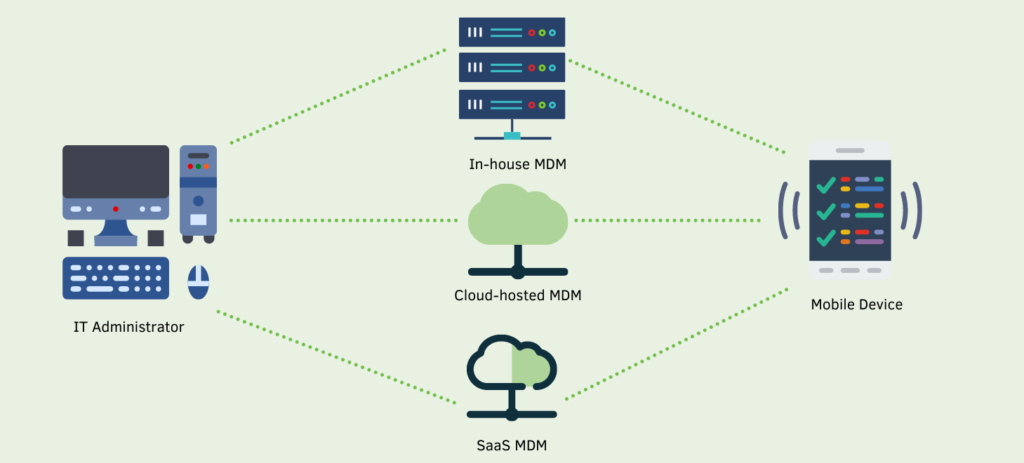
Android Security Management is a vital aspect of Android Mobile Device Management (MDM) software, essential for safeguarding Android devices and sensitive data within organizations. It empowers administrators to enforce security policies, including customizable device passcodes that cater to the organization’s specific needs – from simple to complex.
Additionally, it enables remote locking of Android devices to prevent unauthorized access and facilitates the use of remote alarms to identify lost devices swiftly. In case of theft or potential data breaches, remote wipe capabilities come to the rescue, allowing administrators to erase data and prevent any unauthorized data access.
Furthermore, the option for a corporate wipe ensures the secure removal of confidential corporate data, such as emails and documents, safeguarding the organization’s interests. With continuous monitoring and real-time threat detection, Android Security Management guarantees that devices are shielded from potential risks, ensuring a secure and compliant mobile environment.
Audits and reports
The Audits and Reports feature in Mobile Device Management (MDM) software empowers organizations with comprehensive insights into their managed devices. This functionality enables administrators to perform assertive monitoring by continually generating updated reports on the status and activities of Android devices.
These reports cover crucial aspects such as device compliance, security settings, software inventory, app usage, user activity, and device health. By leveraging these customized reports, administrators can efficiently assess device performance and security, identify potential issues, and make informed decisions.
Moreover, the ability to generate personalized reports based on specific criteria, like apps by devices or devices by model, further enhances decision-making capabilities, enabling organizations to maintain optimal device performance and security levels effectively.
GPS Location Tracking
Mobile Device Management (MDM) software offers a crucial capability of real-time GPS location tracking for Android devices, providing organizations with the ability to monitor and track the exact geographical positions of their managed devices on a map.
Through the utilization of Global Positioning System (GPS) technology, administrators can efficiently pinpoint the current locations of devices, facilitating asset tracking, geofencing, and remote device management. Additionally, the MDM solution enables tracking of historical user and device locations, ensuring a comprehensive record of movements over time.
Such functionality empowers organizations to implement advanced features like geo-fencing, bolstering security measures, and enhancing overall fleet management. In cases of device theft or loss, the GPS tracking feature proves invaluable, aiding in the recovery of misplaced devices and ensuring better visibility and control over the managed Android devices’ whereabouts.
Secure Android Kiosk Mode
Android Device Management (MDM) software offers a transformative feature known as Secure Android Kiosk Mode, empowering organizations to convert ordinary consumer Android tablets or smartphones into dedicated purpose-driven devices.
By configuring kiosk mode, businesses, retail establishments, and educational institutions can effectively lock down these devices to run only a predefined application or a set of approved applications. This stringent restriction prevents users from accessing any unapproved apps or altering crucial Android system settings, ensuring a focused, controlled, and secure user experience.
The beauty of Kiosk Mode lies in its ability to safeguard device integrity and protect sensitive data while minimizing the risk of misuse. It caters to specific scenarios where devices serve distinct purposes, making them reliable tools for enhanced productivity and maintaining a seamless and protected workflow.
Installing Android Apps and Content
The Installing Android Apps and Content feature in Mobile Device Management (MDM) software empowers administrators to efficiently manage app and content distribution on Android devices.
It offers two convenient installation options: either push and install Android application APKs directly from the MDM or enable users to install managed and approved apps from Managed Google Play Store or the Enterprise App Store. The deployment process is streamlined, as apps and content can be installed silently, eliminating the need for user intervention on the device.
Additionally, MDM allows bulk transfer of files and content to devices, facilitating seamless access to essential resources. A remarkable feature is the relay-based file transfer, which optimizes bandwidth usage by pushing content from a local server on the customer’s network, particularly useful for downloading large files. With these capabilities, organizations can enhance productivity and maintain device functionality across their Android device fleet effortlessly.
Profiles and Policies for Company-owned and Employee-owned Devices
The Profiles and Policies feature in Mobile Device Management (MDM) software enables organizations to create distinct configurations, restrictions, and security policies for both company-owned and employee-owned (BYOD) devices, ensuring granular control while respecting users’ privacy.
Android Enterprise by Google further enhances Android MDM solutions with powerful features like Work Profile for BYOD devices. This allows business apps and data to be visible and controlled by the organization’s IT team, while personal apps and data remain private to employees.
Moreover, Android MDM enables strict corporate password compliance and the ability to wipe company apps and data when necessary, ensuring a secure and optimized experience for all devices, aligning perfectly with the organization’s specific needs and policies.
Troubleshooting Android device issues with Remote Control
The Android device management tool with a Remote Control feature offers IT administrators the ability to efficiently troubleshoot device software and configuration issues by gaining full control of Android devices remotely.
Through this tool, IT technicians can access the device screen in real time via their browser and interact with the device using their computer keyboard and mouse. This capability empowers support teams to diagnose and resolve technical problems directly on the device, reducing downtime and enhancing the overall user experience.
With the elimination of the need for physical access to the device, organizations can improve support efficiency, ensuring smooth device operation and maximizing productivity.
Asset Tracking and Reporting
The Asset Tracking and Reporting feature in Mobile Device Management (MDM) software empowers organizations with a comprehensive system to effectively monitor and manage their device inventory.
Through this capability, administrators gain valuable insights into their Android devices, including precise information on device count, installed applications, battery status reports, and other relevant details. This real-time data allows for efficient asset management throughout the entire lifecycle of the devices, aiding in tracking lost or stolen devices and facilitating informed decision-making for optimal device utilization and cost-effective fleet management.
With Android MDM tools, organizations can ensure their Android devices are managed seamlessly and kept up to date, empowering them to streamline operations and enhance productivity.
Android MDM: GMS vs AOSP explained
MDMApp Android, short for Mobile Device Management Applications for Android devices, can be built on either GMS (Google Mobile Services) or AOSP (Android Open Source Project). GMS comes with pre-installed Google apps and APIs, including access to Google Play Store and other services. On the other hand, AOSP offers more customization and control.
Understanding the differences between GMS and AOSP is crucial for businesses to choose the right MDM solution for their Android devices.
| Android management features | Android MDM with GMS device | Android MDM with AOSP device |
| App store | Google Play Store | None |
| Firmware updates | OEM managed (no user control) | None / Limited |
| Push notifications | Google Firebase | None |
| Location services | Google Play Services for location | None |
| Security patches | Google security patches (from OEM) | None |
| Content cloud | Not included | None / Limited |
| App delivery infrastructure | Google Play Store | None / Limited |
| Web app platform | Google Chrome | None / Limited |
| Device debugging | Crashlytics | None |
Android MDM for Device Lifecycle Management
Android MDM (Mobile Device Management) for Device Lifecycle Management offers businesses a comprehensive solution to efficiently manage and secure their Android devices throughout their lifecycle. From device enrollment to decommissioning, this solution enables organizations to seamlessly control and protect their smartphones, tablets, and other Android devices.
The initial step in Android mobile device management involves enrolling the devices into an Android MDM solution. Subsequently, you proceed to provision the devices, which includes the installation and configuration of apps, application of security policies, and pushing content to the Android devices. Once the provisioning is complete, these Android devices are distributed or delivered to the designated users.
Once the devices are actively in use, the Android MDM tool facilitates the management and monitoring of these devices to ensure their continued security and compliance. In the event of non-compliance, the Android Device Management solution can be employed to take necessary remedial actions.
Finally, when the devices become outdated or reach the end of their life cycle (EOL), they are retired or decommissioned from the Android MDM solution.
Types of Devices Managed by Android MDM
Android MDM (Mobile Device Management) solutions are capable of managing a wide range of Android devices used in various environments. These include Android smartphones, tablets, rugged devices utilized in industries like construction and logistics, as well as devices deployed as kiosks or digital signage. Android MDM can also handle point-of-sale (POS) systems, wearable devices like smartwatches, and virtual or emulated devices used for development and testing purposes.
Android MDM ensures secure and streamlined management of these diverse devices across different industries. With its comprehensive device management capabilities, Android MDM empowers businesses to maintain control over settings, data security, and optimal functionality across this broad spectrum of devices.
Android MDM FAQ-
What is the cost of Android MDM?
Oxford Economics and Samsung conducted research on Android Mobile Device Management (MDM) solutions, revealing that the monthly cost per device ranges from $3.25 to $9.50. Consequently, managing a fleet of 100 devices would incur an annual expense of $3,925 to $10,200.
How to set up an Android MDM?
To set up an Android MDM, you need to enroll the device in the MDM and configure it with the necessary policies. This might involve installing the MDM app on the device and setting up authentication methods. Configure desired policies and settings, like passcode requirements and app restrictions. Once enrolled, the MDM can effectively manage the device and its data, ensuring security and compliance.
Is it possible to control Android devices remotely?
It is indeed possible to remotely control Android devices. With Android MDM solutions, IT admins can remotely manage, monitor, and secure business-owned Android devices from a centralized console, regardless of their location. This enables the enforcement of device management policies, enhances security, and prevents potential device misuse or breaches. Android MDM empowers organizations to efficiently control their mobile fleet, ensuring smooth operations and data protection.
What is Android BYOD?
Android BYOD (Bring Your Own Device) is an approach that allows employees and students to use their personal Android smartphones or tablets for work or educational purposes. With this model, individuals bring their own devices to access business applications and data, whether on-premises or in the cloud, promoting flexibility and choice in the workplace or educational environment.
What is Android Kiosk Mode?
Android Kiosk Mode is a feature that locks down a device to restrict its use to a single application or a few allowed applications. It is particularly useful in scenarios where devices are intended for specific tasks, like interactive customer service stations or self-service kiosks in retail, digital signage, and other frontline worker applications
Android MDM solutions enable easy configuration and management of Kiosk Mode, making it an efficient choice for large-scale deployments across various industries. The controlled environment ensures enhanced security, reduced distractions, and dedicated device usage for optimized productivity and user experience.
Conclusion
In conclusion, understanding what MDMApp is and its purpose is crucial for Android users. MDMApp, or Mobile Device Management App, plays a significant role in managing and securing Android devices within enterprises. It helps businesses streamline device management, ensure data security, and optimize device performance.
By implementing an Android MDM solution, organizations can effectively manage the entire device lifecycle and enhance productivity while maintaining data privacy and compliance
Whether you are an enterprise looking to implement MDM or an individual concerned about the presence of MDMApp on your device, this comprehensive guide has provided valuable insights. Stay informed and make informed decisions about your Android device management needs.

